The Cornell Lab Bird Academy › Discussion Groups › Joy of Birdwatching › Activities: Local Bird Exploration
-
Activity 3: I explored the bar charts on eBird and not only did I learn about birds I didn't know passed through my area, I learned some birds I didn't even know existed! Some I would be excited to see are: the Barnacle Goose, Gadwalls, Canvasbacks, Red-necked grebes, and gallinules. I'm excited to keep exploring the lake by my home and see more of these birds!
-
Activity 3: The five birds I learned about this week that pass through my area that I didn’t know were near but would love to see are: Yellow-Cedar Waxwing (listed as rare but I’d love to see one), Yellow-billed cuckoo, Eastern Phoebe and two I’d like to find in a wetland area a short drive away would be: Great Blue Heron and a Common Loon (rare but may pass this way). I will be on the lookout and hope I spot some of these this spring.
-
Activity 2: It was great to use Merlin’s “Most Likely” species feature. I was so pleased they have the birds picture as well as various bird songs and calls. I was on my porch so was not close enough to make a recording of any but when I heard one I was able to listen to a couple possibilities and identify the correct bird to match what I heard. This will really help with my goal to know what birds in my area I am hearing. For example. I see Cardinals often but did not know for sure what their sound was. One learned . . . hundreds to go!

-
Activity 1: I found the Merlin App to be very helpful as I watched and listened to birds in my back yard this morning. I saw / heard the following: American Robin, Northern Cardinal, Tree Swallow, Carolina Chickadee (I think), sparrow, Pine Warbler, American crow, Purple Martin – Pretty good for 30 minutes!
-
Activity 1: Today, in my backyard in 15 minutes, I saw many Black-capped and Chestnut-backed Chickadees, Dark-eyed (Oregon) Juncos, American Goldfinches and House Finches as well as 1 or 2 of each; Anna's Hummingbirds, Song Sparrows, Spotted Towhees, Bushtits, Red-breasted Nuthatches, Northern Flickers, Downy Woodpeckers, Bewick's Wrens, and Steller's Jays. Pretty typical! I can identify 10-15 species in any similar timeframe with others jumping into the mix at different times. I heard but did not see a Merlin!
-
Activity #1: Today on my birdwatch at my feeder in Eastern Ontario I saw the following birds: Canada Geese, Mourning Dove, Downy Woodpecker, Hairy Woodpecker, Blue Jays, American Crows, Black-capped Chickadees, White-breasted Nuthatch, European Starlings, American Robins, House Sparrows, Red-winged Blackbirds, Common Grackles and Northern Cardinals.



-
Activity 1: A pair of osprey are working on building a nest on a channel marker in the Currituck Sound. Several Canada geese in the area. A few Black Ducks and Double Crested Cormorants. Red-winged Blackbird on another platform. Lots of American Robins.
-
Activity 3 Using Merlin - Explore Birds I was delighted to see a quite a few birds that I have never seen, showing up as in my area! Wood Ducks, Tundra Swan, Pine Grosbeak, Snow Bunting, Bohemian Waxwing, and long tailed duck. How exciting. I wish Merlin would tell me where they are!
-
Activity 2 Just in my neighbourhood, Merlin suggested that the following birds were out and about: Starlings, nuthatch, crow, blue jay, Mourning dove, robin, chickadee and gold finch. While I didn't see them all I did get to see some. Blue Jay, Starlings (lots), Mourning dove and chickadee. From my hood: The European Starling
 Mourning Dove
Mourning Dove
 Blue Jay
Blue Jay

-
Activity 1: This past weekend I partcipated in a waterfowl outing with our local naturalist group. It was very informative and interesting as the only water fowl that I really see are Canada Geese and Mallards. The day showed us that there is indeed many other type of ducks out there! Oh and the birds that are starting to follow through. It was a great day for viewing. As I really am not all that familiar with the duck-clan, while editing my pictures I found myself turning to Merlin and my pocket field guide to confirm the type of bird that I was viewing. The American Black Duck - which was amongst the other Mallards and hard to decipher. The look the same, are the same size, but colouring is slightly different and the bill is yellow.
 The Hooded Meganser - Wow what do you say about these guys! Not quite as colourful as a Wood Duck, but oh so pretty. Once again it is the size of a mallard and by the colours on these two, they are males. I once again used my pocket guide and confirmed the ID by uploading the picture to Merlin.
The Hooded Meganser - Wow what do you say about these guys! Not quite as colourful as a Wood Duck, but oh so pretty. Once again it is the size of a mallard and by the colours on these two, they are males. I once again used my pocket guide and confirmed the ID by uploading the picture to Merlin.
 Trumpeter Swan
Apparently we host different swans here in Ontario--tundra, (which I have never seen), Mute and Trumpter that I know of. I always get confused between the Mute and Trumpeter swans and it was no difference here as I had to go online to remind me which was which. I tend to refer to them as the good and bad swan. Mutes are regarded to be more graceful and beautiful with their curved necks and black and orange bills, but their aggressive behavior and voracious appetites can often damage local ecosystems--hence by bad swan reference. The Trumpeter swan is now making a come back from it's almost extinct status and can be identified by it's black beak and loud trumpeting. Beautiful elegant birds. If you're lucky to see them taking off or landing, it is amazing to note the size of the wings when fully out stretched that the noise the wings make as they pick up air.
Trumpeter Swan
Apparently we host different swans here in Ontario--tundra, (which I have never seen), Mute and Trumpter that I know of. I always get confused between the Mute and Trumpeter swans and it was no difference here as I had to go online to remind me which was which. I tend to refer to them as the good and bad swan. Mutes are regarded to be more graceful and beautiful with their curved necks and black and orange bills, but their aggressive behavior and voracious appetites can often damage local ecosystems--hence by bad swan reference. The Trumpeter swan is now making a come back from it's almost extinct status and can be identified by it's black beak and loud trumpeting. Beautiful elegant birds. If you're lucky to see them taking off or landing, it is amazing to note the size of the wings when fully out stretched that the noise the wings make as they pick up air.  We were so lucky as well to view as well, common golden eye, common mergansers, canada geese, a bald eagel, pileated woodpecker, robins, downy woodpecker, chickadee and mourning doves. We even had the chance to see a mink up-close-and-personal as he ran across the ice in a partially open bay. It was a great day for birding.
We were so lucky as well to view as well, common golden eye, common mergansers, canada geese, a bald eagel, pileated woodpecker, robins, downy woodpecker, chickadee and mourning doves. We even had the chance to see a mink up-close-and-personal as he ran across the ice in a partially open bay. It was a great day for birding. -
Activity 3: I used EBird to look at bar charts and range maps and found many birds that I didn’t know were in my area (central MA) during late winter/early spring, including Pine Grosbeak, Northern Pintail, Northern Shrike, Common Redpole and Fox Sparrow.
-
Activity 1: I saw Northern Cardinals, House Finches, Mourning Doves, Chickadees, Tufted Titmice, Nuthatches, Downy Woodpeckers and a White Throated Sparrow. All of which are common to my area (central MA)
-
I saw Northern Cardinals, American Crows, Blue Jays (a lot of them!), Carolina Chickadees, Carolina Wrens, Eastern Bluebirds, Yellow-Shafted Norther Flicker, Downy Woodpecker, Hairy Woodpecker, American Goldfinch, Red-winged Blackbirds (a lot of them, they are really cleaning out my feeders these days), House Sparrows, House Wrens, Dark-eyed Juncos, Mourning Doves, Starlings, Canada Geese, Mallards, Common Grackles, and a Great Egret who flew over the street.
-
I successfully sleuthed out my first hard to identify bird! Two female redwing blackbirds were at my suet feeder this morning. Merlin did not come up with it as an option and sound ID didn't help. They were feeding amongst the goldfinches and house finches; bigger than they house finch but looked more like a too big sparrow. All about birds had an exact photo "Female (California Bicolored)" although I'm in SW Utah at 6000 ft. Woohoo!

-
Activity 2: After looking at the list of likely birds in my area on the Merlin App, I went out for a walk in my neighborhood. Using the Sound ID feature I recorded a number of birds including a Pine Warbler. While I didn't actually see him, the app allowed me to identify him by his song. I have been using the App since last summer and had forgotten about the Most Likely feature.
-
Activity 1: I looked out my window for 15 minutes and saw the following birds. White-throated Sparrow, Tufted Titmouse, Carolina Chickadee, Northern Cardinal, Yellow-rumped Warbler, Downy Woodpecker and heard an American Crow.
-
Activity 3 I looked at bar charts specifically for February in our area. I found 13 reported birds that I did not know were in our area. Of them, 8 do not have range maps that include this area, so I "assume" they are accidental. The remaining 5 are: Chestnut collared Longspur Gray Catbird Dusky Grouse Canada Jay Lillian/Chihuahuan Meadowlark
-
I looked out of my window in Bangalore India this morning and noticed 4 Bird species in about 10 min 1. Cinereous Tit 2. Red Whiskered Bulbul 3. Purple Rumped Sunbird 4. Pale billed Flower pecker
-
Activity 1: I watched the BirdCam link for 15 minutes and saw at least 4 species of bird: male downy woodpecker, purple finch, red breasted nuthatch, and common redpoll.
-
Activity 3: I used eBird to see what birds have been seen within 5 km of me in the past week. I didn't know that Merlins and Northern Mockingbirds (fun to learn about their call!) could be found right here. When I expanded the range to 10 km, there was also the Winter Wren and White-winged Scoter (which, interestingly, is not on the list of likely birds in Merlin for my area right now; also I had never heard of a "scoter" of any kind) and the Common Goldeneye (which I didn't even know was a kind of duck until I looked it up).
-
Activity 2: I did not see many birds out walking today, but the ones I saw are on the list of most likely in my area: Northern Cardinal (male), House Sparrow (many, chatting in a shrub), and American Robin.
-
I live in the Midwest so winter is here and the birds are small in number. However, I have seen two sets of young mourning doves, a male cardinal, a house sparrow and a Blue Jay at our feeders on our patio. Today I saw a small bird that might be a woodpecker. It ate pointing down with his feet clamped unto the feeder. It flew away before I could study its coloring. It did have a somewhat long narrow beak.
-
 using Merlin app, I discovered three species of birds singing at the same time (this app is amazing): blue-gray tanager, rufous-collared sparrow, tropical kingbird.
These birds are common in my local area (Panama City) as well as in Boquete, where I saw the resplendent quetzal during a birdwatching tour right before completing this topic.
in this tour we saw hummingbirds, and slaty flowerpiercers. (not many birds because we went exclusively to find a quetzal).
recommendation: if you ever visit Panama 🇵🇦 go to Boquete anytime from mid January to April, there’s good chance to see quetzals.
using Merlin app, I discovered three species of birds singing at the same time (this app is amazing): blue-gray tanager, rufous-collared sparrow, tropical kingbird.
These birds are common in my local area (Panama City) as well as in Boquete, where I saw the resplendent quetzal during a birdwatching tour right before completing this topic.
in this tour we saw hummingbirds, and slaty flowerpiercers. (not many birds because we went exclusively to find a quetzal).
recommendation: if you ever visit Panama 🇵🇦 go to Boquete anytime from mid January to April, there’s good chance to see quetzals. -
Activity 1: I watched a few minutes of a BirdCam based in Ontario, Canada. In the short time I viewed this I saw several chickadees, they mostly grabbed what was down in the lower pan, though a few fed from the feeder above. When they left, a group of red-capped small brown and white birds arrived. Later investigation revealed these to be common redpols. A medium sized red bird with black and white wings arrived, and was joined by two others. These were pine grosbeaks, later a female pine grosbeak joined them. The female was distinguished by an orange, or rust colored coloration in place of the red of the males. These birds all fed together, leaving and returning in short intervals, until a squirrel came and caused them all to disperse. Most went down to the ground below and fed on seeds which had blown off the feeder station. The squirrel remained for about 3 minutes before leaving, at which point the grosbeaks and redpols returned.
-
Activity 2: Of the top 25 birds “most likely” in Ottawa, Ontario, Canada, today, I saw 13 while birding this morning. If I add in my walk yesterday, I get to 17. At this time of year, even the migrants are getting to be fewer, so the 13 to 17 to 25 will be the main birds I see for the next while, although I did see four or five more birds in the past two days that go beyond the top 25 “most likely”, so there is always some variety when one just gets ups and out.
Read More:

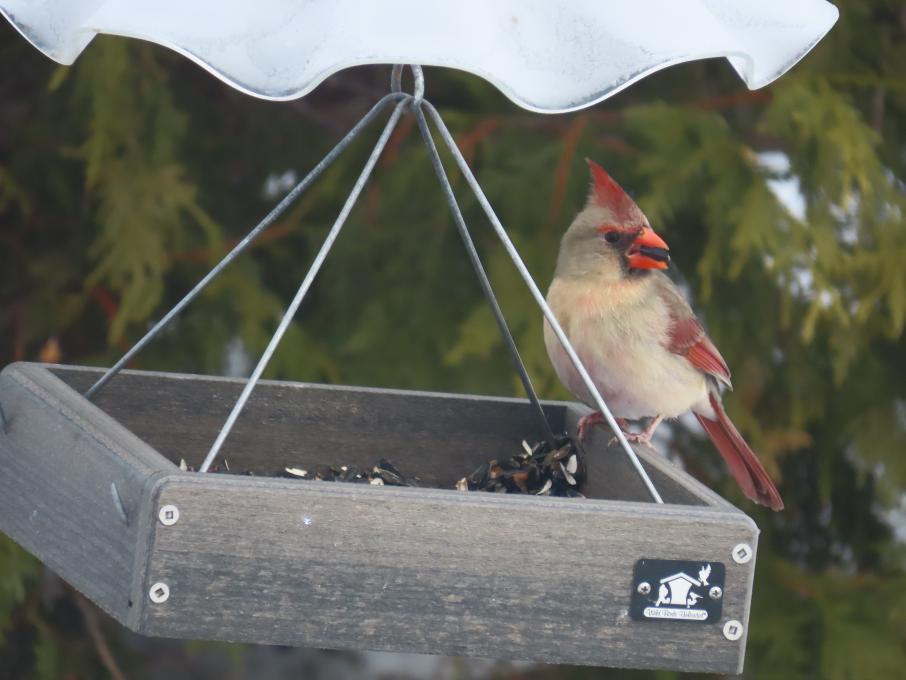
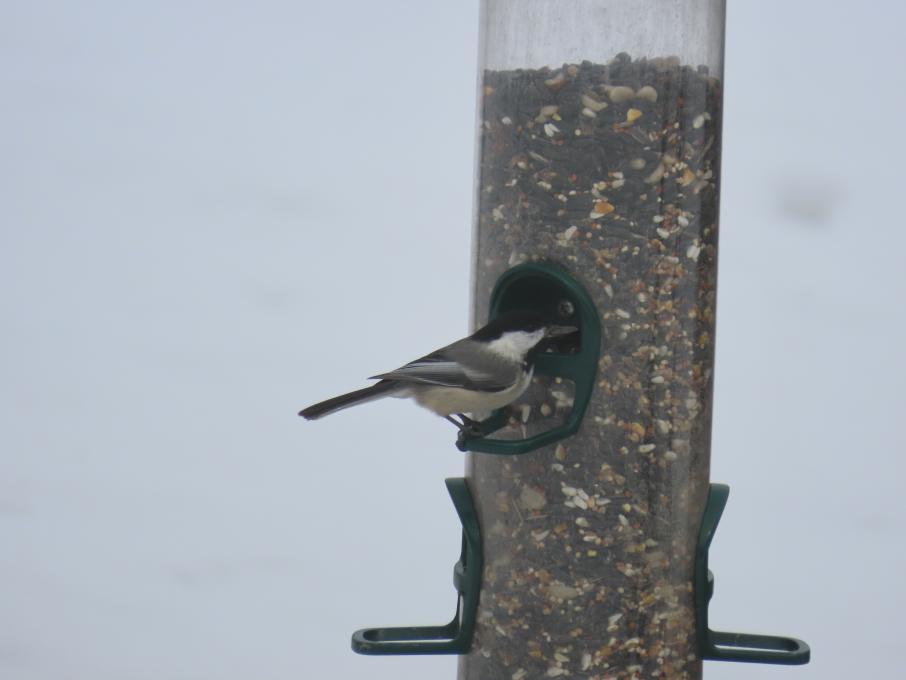

 Mourning Dove
Mourning Dove
 Blue Jay
Blue Jay
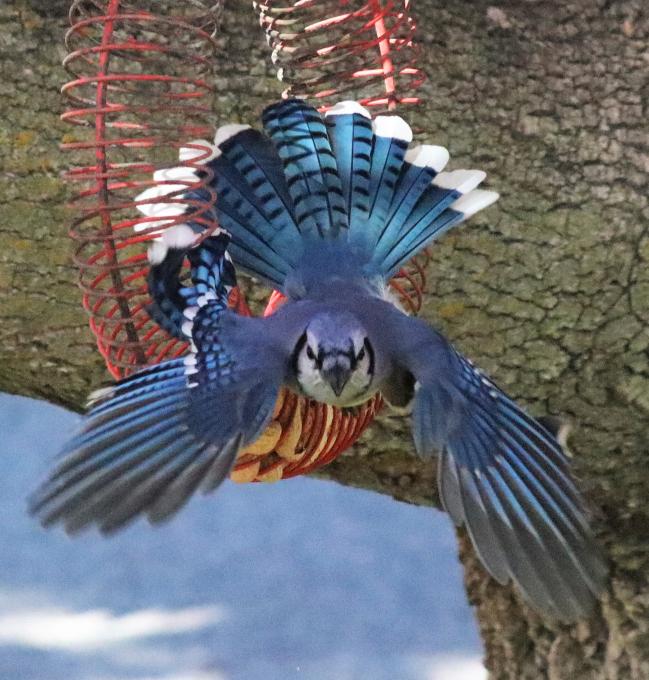
 The Hooded Meganser - Wow what do you say about these guys! Not quite as colourful as a Wood Duck, but oh so pretty. Once again it is the size of a mallard and by the colours on these two, they are males. I once again used my pocket guide and confirmed the ID by uploading the picture to Merlin.
The Hooded Meganser - Wow what do you say about these guys! Not quite as colourful as a Wood Duck, but oh so pretty. Once again it is the size of a mallard and by the colours on these two, they are males. I once again used my pocket guide and confirmed the ID by uploading the picture to Merlin.
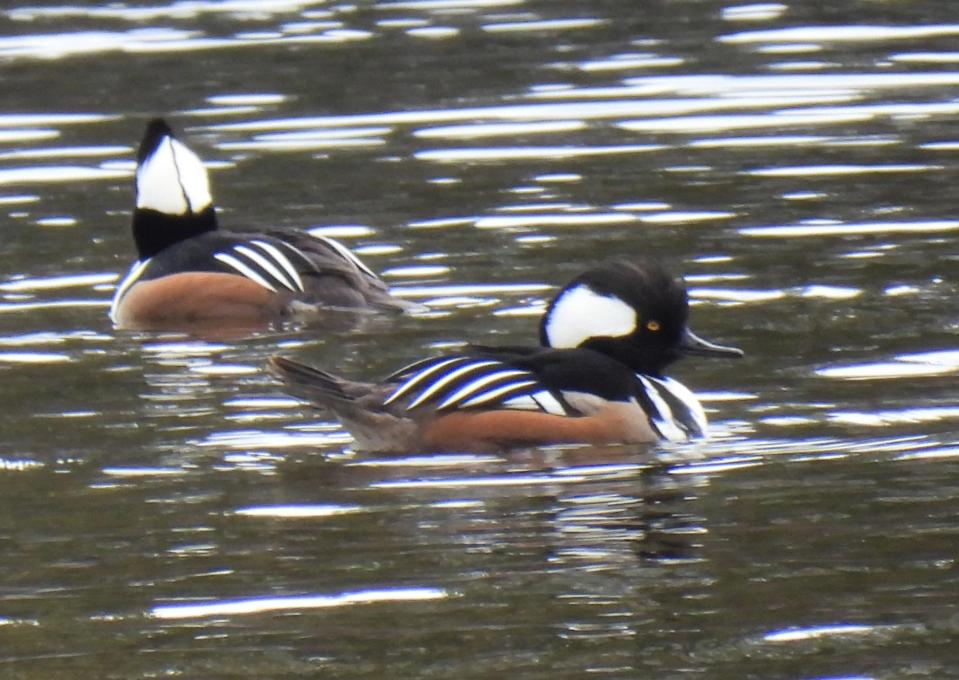 Trumpeter Swan
Apparently we host different swans here in Ontario--tundra, (which I have never seen), Mute and Trumpter that I know of. I always get confused between the Mute and Trumpeter swans and it was no difference here as I had to go online to remind me which was which. I tend to refer to them as the good and bad swan. Mutes are regarded to be more graceful and beautiful with their curved necks and black and orange bills, but their aggressive behavior and voracious appetites can often damage local ecosystems--hence by bad swan reference. The Trumpeter swan is now making a come back from it's almost extinct status and can be identified by it's black beak and loud trumpeting. Beautiful elegant birds. If you're lucky to see them taking off or landing, it is amazing to note the size of the wings when fully out stretched that the noise the wings make as they pick up air.
Trumpeter Swan
Apparently we host different swans here in Ontario--tundra, (which I have never seen), Mute and Trumpter that I know of. I always get confused between the Mute and Trumpeter swans and it was no difference here as I had to go online to remind me which was which. I tend to refer to them as the good and bad swan. Mutes are regarded to be more graceful and beautiful with their curved necks and black and orange bills, but their aggressive behavior and voracious appetites can often damage local ecosystems--hence by bad swan reference. The Trumpeter swan is now making a come back from it's almost extinct status and can be identified by it's black beak and loud trumpeting. Beautiful elegant birds. If you're lucky to see them taking off or landing, it is amazing to note the size of the wings when fully out stretched that the noise the wings make as they pick up air. 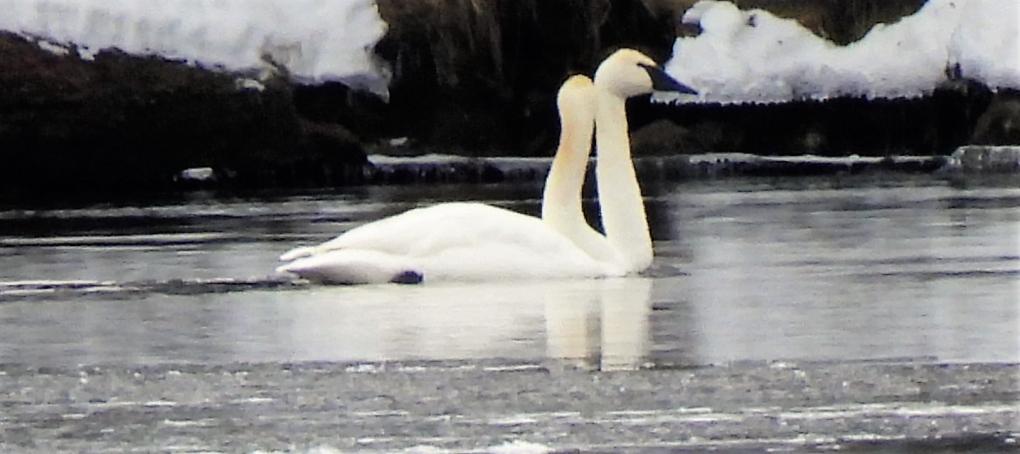 We were so lucky as well to view as well, common golden eye, common mergansers, canada geese, a bald eagel, pileated woodpecker, robins, downy woodpecker, chickadee and mourning doves. We even had the chance to see a mink up-close-and-personal as he ran across the ice in a partially open bay. It was a great day for birding.
We were so lucky as well to view as well, common golden eye, common mergansers, canada geese, a bald eagel, pileated woodpecker, robins, downy woodpecker, chickadee and mourning doves. We even had the chance to see a mink up-close-and-personal as he ran across the ice in a partially open bay. It was a great day for birding. 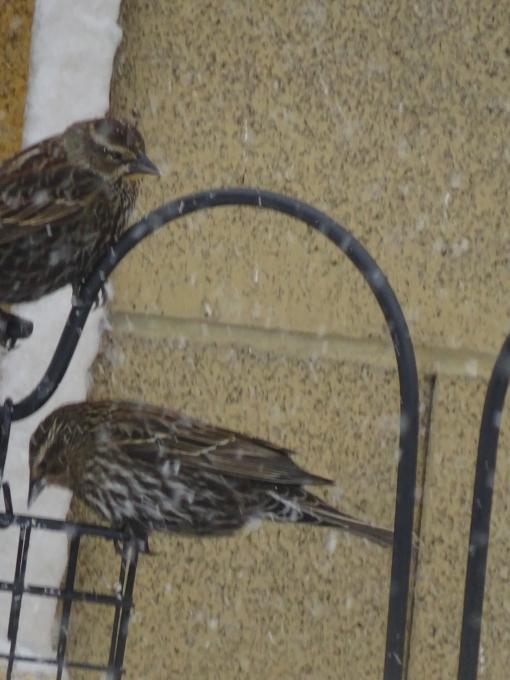
 using Merlin app, I discovered three species of birds singing at the same time (this app is amazing): blue-gray tanager, rufous-collared sparrow, tropical kingbird.
These birds are common in my local area (Panama City) as well as in Boquete, where I saw the resplendent quetzal during a birdwatching tour right before completing this topic.
in this tour we saw hummingbirds, and slaty flowerpiercers. (not many birds because we went exclusively to find a quetzal).
recommendation: if you ever visit Panama 🇵🇦 go to Boquete anytime from mid January to April, there’s good chance to see quetzals.
using Merlin app, I discovered three species of birds singing at the same time (this app is amazing): blue-gray tanager, rufous-collared sparrow, tropical kingbird.
These birds are common in my local area (Panama City) as well as in Boquete, where I saw the resplendent quetzal during a birdwatching tour right before completing this topic.
in this tour we saw hummingbirds, and slaty flowerpiercers. (not many birds because we went exclusively to find a quetzal).
recommendation: if you ever visit Panama 🇵🇦 go to Boquete anytime from mid January to April, there’s good chance to see quetzals.